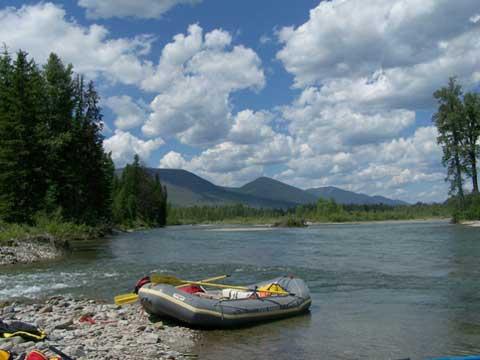Both U. S. Senators from Montana say they will introduce a bill to ban mining and oil and gas development on federal lands in the North Fork Flathead drainage, which forms the western boundary of Glacier National Park. The announcement comes after Canadian officials took similar steps north of the border.
As reported recently in the Traveler, conservationists had cheered the recent announcement that British Columbia will not allow mining in the Canadian Flathead just north of Glacier National Park and due west of Waterton Lakes National Park. For years environmental and conservation groups on both sides of the border have been fighting projects to mine coal, coal-bed methane, and gold in the area.
Now comes news that both U. S. Senators from Montana—Max Baucus and Jon Tester—plan to introduce legislation to ban all mining, oil and gas development and coalbed gas extraction on federal lands known as the North Fork Flathead drainage. The area is located adjacent to Glacier National Park and drains into Flathead Lake.
The area derives its name from the North Fork of the Flathead River; a U.S. Forest Service website describes the river:
The North Fork Flathead River originates 50 miles across the border in British Columbia, Canada. The river brings with it the rugged remoteness that one would expect from the Canadian Rockies. The remoteness is what brings people to this part of Montana and it’s the scenic beauty that keeps bringing them back.
The North Fork Flathead River divides the Flathead National Forest from Glacier National Park. The upper 41 miles above the Camas Creek Bridge are classified as Scenic under the 1976 Wild and Scenic Rivers Act. The lower 17 mile section to Blankenship Bridge and the confluence of the Middle Fork is classified as Recreational. Awe inspiring views into Glacier National Park are common from the river.
The group American Rivers notes,
This special watershed harbors the greatest diversity of plants and animals in the Rocky Mountains and serves as the last intact wildlife corridor for grizzly bears, Canadian lynx, and wolves along the U.S.-Canada border. It also supports threatened bull trout and westslope cutthroat, some of which migrate to Canada to reproduce.
Both Senators had pressed for Canadian action on the proposed mining, and have responded to recent news from British Columbia with their own joint statement:
“Canadians and Americans—and especially Montanans—are forever linked by the beautiful Flathead valley,” Baucus said. “Together, we live, work, and prosper because of the resources in this valley. We must step up and protect this gem—and our outdoor heritage for future generations, no matter which side of the border we live on.”
“Keeping pollution out of the Upper Flathead isn’t just important to Montana—it’s important to the entire world,” Tester said. “Canada stepped up to be a good neighbor, and now we’ll do our part to safeguard this area so our kids and grandkids can fish, hunt, hike and camp in it like we do.”
Will Hammerquist, Glacier Program Manager for the non-profit National Parks Conservation Association, supports the Senator’s efforts.
“Every Montanan who cares about passing on our great outdoor heritage should applaud Senators Baucus’ and Tester’s legislation to retire these oil leases. This is another significant step by Senator Baucus in his 30-year commitment and leadership to protect Glacier and its surrounding lands.
Over 90 percent of the land-base in the U.S. North Fork is publically owned federal land; and only through the leadership of Montana’s Senators at the federal level can such a significant policy change be made. I can’t think of a better birthday present to celebrate Glacier National Park’s Centennial.”
There are reported to be a small number of existing but inactive mineral leases in the area covered by the proposed ban. Citing similar recent actions on the opposite side of Glacier National Park last month, Baucus says existing leases on the North Fork could be bought out or swapped for leases in other areas.
The senator's intention to introduce a bill doesn't guarantee passage, of course, but it's an important step; without their support, such congressional action would be virtually impossible. The area to be included in the proposed ban is yet to be defined, but even so, this announcement is an important one—it has important symbolic as well as practical value, since it was initiated by two Western senators.
Just over a year ago, there were contentious battles over proposed oil and gas leases adjacent to several NPS sites in Utah. Interior Secretary Salazar has since put the most controversial leases on hold, pending further review.
Perhaps Salazar's actions in Utah and these steps by Montana's senators can serve as a reminder that "multiple uses" on U. S. Forest Service and B.L.M. lands adjacent to parks can include non-consumptive activities as well as active energy development.
On the national level, with thoughtful analysis, there's room on public lands for both.


 Support Essential Coverage of Essential Places
Support Essential Coverage of Essential Places






